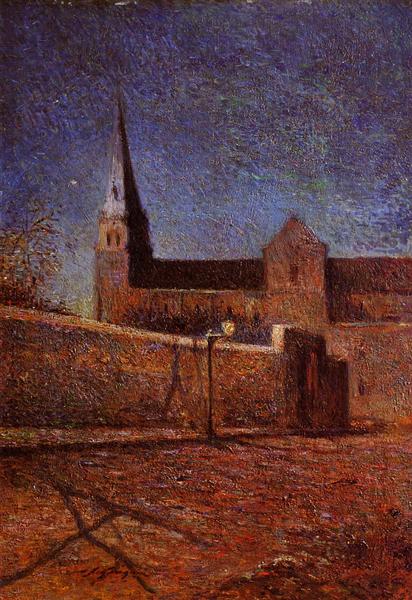Beschreibung
Paul Gauguin's painting "Church at Vaugirard" (1879) is a work that, although not as well known as his later explorations into symbolism and emotivity, reflects an important stage in the evolution of his style and artistic vision. This work, created during his early years in Paris, is situated in the context of post-impressionism, where the search for color and form are combined in a unique personal expression.
In the composition "Church of Vaugirard", Gauguin shows the church, a stone building with strong, geometric lines, rising against an almost clear sky. The structure of the church, located in Vaugirard, a district south of Paris, is surrounded by a landscape that invites contemplation. The painting presents a strong relationship between the architectural space and the natural context that surrounds it. The golden light that bathes the environment, together with the vibrant greens of the grass, suggests a time of day when the light becomes softer, revealing an almost serene atmosphere that encourages reflection.
The colours of the work are a crucial element in its interpretation. Gauguin uses a palette of earthy tones, alongside deep greens and yellows, to create a contrast that brings each element of the scene to life. The dark hues in the church contrast with the more vivid colours surrounding the house of God, causing a tension that adds depth to the depiction. This colour choice is not only aesthetically appealing, but also provides a sense of warmth and highlights the connection between the building and its natural surroundings. By using visible, schematic brushstrokes, Gauguin begins to move away from the precision of Impressionism, whilst suggesting a transition towards his future use of colour as a carrier of symbolic meaning.
Although there are no human figures in this work, the presence of the community surrounding this sacred space can be felt. Vaugirard's church is presented as a meeting place, a refuge within a landscape that is no longer the same as that of the most archaic traditions, suggesting the modernity that was taking hold in Paris at the end of the 19th century. In this way, the absence of characters can be interpreted as a way of focusing attention on the place itself, highlighting its importance in the community fabric of the time.
Gauguin, by choosing to depict a church as part of his artistic exploration, also enters into a dialogue about spirituality and modern life. In this sense, the painting can be seen as a reflection on the sense of place at the heart of a changing city and the role that institutions play in daily life. Although this work is an example of an earlier Gauguin, the way in which he approaches space and colour foreshadows the boldness that will characterise his later work in Pont-Aven and his transition towards more expressive and symbolic forms.
In conclusion, “Church at Vaugirard” is more than just a depiction of a building; it is a painting that encapsulates a moment of searching and transition in Gauguin’s career. Through its treatment of color and composition, and its engagement with themes of community and spirituality, the work establishes a dialogue between the modern world and tradition, a tension that is central to understanding the evolution of this remarkable artist. This painting is rooted in the milieu of late 19th-century Paris and anticipates a deeper exploration of symbols in Gauguin’s future works, whose contribution to art continues to resonate through the centuries.
KUADROS ©, a famous painting on your wall.
Hand-made oil painting reproductions, with the quality of professional artists and the distinctive seal of KUADROS ©.
Painting reproduction service with satisfaction guarantee. If you are not completely satisfied with the replica of your painting, we will refund 100% of your money.

